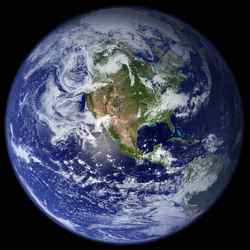
The Earth. Image credit: NASA Click to enlarge
In a new study that provides a novel way of looking at our solar system’s past, a group of planetary scientists and geochemists announce that they have found evidence on Earth of an asteroid breakup or collision that occurred 8.2 million years ago.
Reporting in the January 19 issue of the journal Nature, scientists from the California Institute of Technology, the Southwest Research Institute (SwRI), and Charles University in the Czech Republic show that core samples from oceanic sediment are consistent with computer simulations of the breakup of a 100-mile-wide body in the asteroid belt between Mars and Jupiter. The larger fragments of this asteroid are still orbiting the asteroid belt, and their hypothetical source has been known for years as the asteroid “Veritas.”
Ken Farley of Caltech discovered a spike in a rare isotope known as helium 3 that began 8.2 million years ago and gradually decreased over the next 1.5 million years. This information suggests that Earth must have been dusted with an extraterrestrial source.
“The helium 3 spike found in these sediments is the smoking gun that something quite dramatic happened to the interplanetary dust population 8.2 million years ago,” says Farley, the Keck Foundation Professor of Geochemistry at Caltech and chair of the Division of Geological and Planetary Sciences. “It’s one of the biggest dust events of the last 80 million years.”
Interplanetary dust is composed of bits of rock from a few to several hundred microns in diameter produced by asteroid collisions or ejected from comets. Interplanetary dust migrates toward the sun, and en route some of this dust is captured by the Earth’s gravitational field and deposited on its surface.
Presently, more than 20,000 tons of this material accumulates on Earth each year, but the accretion rate should fluctuate with the level of asteroid collisions and changes in the number of active comets. By looking at ancient sediments that include both interplanetary dust and ordinary terrestrial sediment, the researchers for the first time have been able to detect major dust-producing solar system events of the past.
Because interplanetary dust particles are so small and rare in sediment-significantly less than a part per million-they are difficult to detect using direct measurements. However, these particles are extremely rich in helium 3, in comparison with terrestrial materials. Over the last decade, Ken Farley has measured helium 3 concentrations in sediments formed over the last 80 million years to create a record of the interplanetary dust flux.
To assure that the peak was not a fluke present at only one site on the seafloor, Farley studied two different localities: one in the Indian Ocean and one in the Atlantic. The event is recorded clearly at both sites.
To find the source of these particles, William F. Bottke and David Nesvorny of the SwRI Space Studies Department in Boulder, Colorado, along with David Vokrouhlicky of Charles University, studied clusters of asteroid orbits that are likely the consequence of ancient asteroidal collisions.
“While asteroids are constantly crashing into one another in the main asteroid belt,” says Bottke, “only once in a great while does an extremely large one shatter.”
The scientists identified one cluster of asteroid fragments whose size, age, and remarkably similar orbits made it a likely candidate for the Earth-dusting event. Tracking the orbits of the cluster backwards in time using computer models, they found that, 8.2 million years ago, all of its fragments shared the same orbital orientation in space. This event defines when the 100-mile-wide asteroid called Veritas was blown apart by impact and coincides with the spike in the interplanetary seafloor sediments Farley had found.
“The Veritas disruption was extraordinary,” says Nesvorny. “It was the largest asteroid collision to take place in the last 100 million years.”
As a final check, the SwRI-Czech team used computer simulations to follow the evolution of dust particles produced by the 100-mile-wide Veritas breakup event. Their work shows that the Veritas event could produce the spike in extraterrestrial dust raining on the Earth 8.2 million years ago as well as a gradual decline in the dust flux.
“The match between our model results and the helium 3 deposits is very compelling,” Vokrouhlicky says. “It makes us wonder whether other helium 3 peaks in oceanic cores can also be traced back to asteroid breakups.”
This research was funded by NASA’s Planetary Geology and Geophysics program and received additional financial support from Czech Republic grant agency and the National Science Foundation’s COBASE program. The Nature paper is titled “A late Miocene dust shower from the breakup of an asteroid in the main belt.”
Original Source: caltech News Release
